Vimar 03815 Bruksanvisning
Vimar
Larmsystem
03815
Läs gratis den bruksanvisning för Vimar 03815 (4 sidor) i kategorin Larmsystem. Guiden har ansetts hjälpsam av 32 personer och har ett genomsnittsbetyg på 5.0 stjärnor baserat på 16.5 recensioner. Har du en fråga om Vimar 03815 eller vill du ställa frågor till andra användare av produkten? Ställ en fråga
Sida 1/4

Viale Vicenza, 14
36063 Marostica VI - Italy
www.vimar.com
49401713A0 02 2302
03815
BY-ALARM PLUS
Scatola metallica By-alarm Plus per scheda centrale a 25, 65 o 125 zone, con
4 slot disponibili per scheda espansione 5 In/Out 03808, scheda comunicatore
GSM 03810 o gateway antintrusione 03812, 1 slot disponibile per modulo radio
03832, 1 alimentatore 3,2 A 03805 (6,2 A 03806 per 125 zone), 1 alloggiamento
per batteria da 7Ah (17Ah per 125 zone), tamper per strappo e apertura, instal-
lazione a parete.
La scatola in metallo è provvista di apposite forature che consentono di alloggiare al suo interno la
scheda della centrale 03800-03801-03802 e l'alimentatore 03805 (per 25 e 65 zone) o 03806 (per
125 zone) assieme ad altri dispositivi in funzione degli stessi e dello spazio disponibile.
Le possibili combinazioni sono indicate nella figura DISPOSITIVI INSTALLABILI.
INSTALLAZIONE
Si raccomanda di installare il dispositivo in un luogo poco visibile e di non immediato accesso a
persone estranee.
1.
Aprire il contenitore metallico rimuovendo il coperchio.
2. Fissare la scheda della centrale al fondo metallico.
3. Fissare l'alimentatore al fondo plastico.
4. Fissare il dispositivo antisabotaggio al fondo metallico.
5. Predisporre i cablaggi.
5. Individuare i fori di fissaggio agli angoli del fondo metallico della scatola e il foro di fissaggio del
dispositivo antisabotaggio.
6.
Basandosi sul posizionamento dei fori sulla base, forare il muro facendo attenzione a non creare
danni a tubature, condotte del gas, canalizzazioni elettriche, ecc.
7.
Inserire nel foro di fissaggio del dispositivo antisabotaggio il tassello da 6 mm.
8. Inserire in ognuno degli altri fori, un tassello (diametro consigliato 6 mm).
9. Far passare i cavi all'interno di manicotti pressacavo/passacavo.
10. Fissare il la scatola al muro tramite viti con diametro adatto al tassello.
11. Richiudere il coperchio della scatola.
Nota: I pressacavi/passacavi usati in fase d'installazione devono avere classe d'infiammabilità V-1
o superiore.
Collegamento all'alimentazione di rete
Per l'alimentazione della centrale è necessario prevedere una linea separata derivata dal quadro elet-
trico di distribuzione. Tale linea deve essere protetta da dispositivi di sezionamento e di protezione.
ATTENZIONE: Durante il collegamento alla sorgente primaria, prestare la massima cautela.
Pericolo di folgorazione.
Il dispositivo di sezionamento deve essere posto all’esterno dell’apparecchiatura e facilmente acces-
sibile. La distanza tra i contatti deve essere di almeno 3 mm. Il dispositivo di sezionamento consiglia-
to è un interruttore magnetotermico con curva d'intervento C e corrente nominale massima di 16 A.
L'impianto di terra del sito deve essere realizzato secondo le norme vigenti.
1. Far passare il cavo di alimentazione attraverso il foro passacavi
2. Collegare l’alimentazione di rete agli appositi terminali. Per una installazione conforme agli stan-
dard di sicurezza, il conduttore di fase deve essere collegato al terminale “L”, il conduttore neutro
deve essere collegato al terminale “N”.
3. Evitare che conduttori a bassissima tensione di sicurezza o di segnale possano andare in contat-
to con punti a tensione pericolosa. Usando una fascetta per cavi, assicurare i conduttori insieme
e collegarli saldamente ad uno dei ganci per i cavi sul fondo dell’armadio.
Nota: L’estremità di un conduttore cordato non deve essere consolidata con una saldatura dolce
nei punti in cui il conduttore è sottoposto a una pressione di contatto.
4. Crimpare il cavetto del conduttore di terra al terminale ad occhiello fornito.
5. Fissare il cavetto con l’occhiello con la centrale alla vite della messa a terra con il dado fornito.
6. Assicurarsi che alla messa a terra siano collegati il terminale di terra dell'alimentatore e il coperchio.
Collegamento della batteria tampone
Il contenitore plastico può alloggiare una batteria al piombo da 12V 7Ah (non fornita).
Prestare la massima attenzione nel rispettare la polarità della batteria:
• cavo nero= negativo
• cavo rosso= positivo
Per la connessione della batteria utilizzare l’apposito cavo di collegamento fornito con l'alimentatore
art. 03805 o 03806.
Collegare il cavo alla centrale tramite l’apposito connettore dell’alimentatore.
REGOLE DI INSTALLAZIONE
L’installazione e la configurazione devono essere effettuate da personale qualificato con l’osser-
vanza delle disposizioni regolanti l’installazione del materiale elettrico in vigore nel paese dove i
prodotti sono installati.
CONFORMITA' NORMATIVA.
Direttiva BT. Direttiva EMC. Direttiva RoHS.
Norme EN 62368-1, EN 50130-4, EN 50130-5, EN 55032, EN 61000-3-2, EN 61000-3-3, EN
50131-3, EN 50131-6, EN 50131-10, EN 50136-2, EN IEC 63000.
Regolamento REACh (UE) n. 1907/2006 – art.33. Il prodotto potrebbe contenere tracce di piombo.
By-alarm Plus metal box for 25-, 65- or 125-zone control unit board, 4 slots
available for 5 In/Out expansion board 03808, GSM communicator board 03810
or burglar alarm system gateway 03812, 1 slot available for radio module 03832,
1 3.2A power supply unit 03805 (6.2 A 03806 for 125 zones), 1 housing for 7Ah
battery (17Ah for 125 zones), anti-removal and anti-tamper protection, surface
mounting.
The metal box has suitable holes to accommodate the control unit board 03800-03801-03802 and
power supply unit 03805 (for 25 and 65 zones) or 03806 (for 125 zones) together with other devices,
depending on their sizes and the available space.
The possible combinations are shown in the INSTALLABLE DEVICES figure.
INSTALLATION
We recommend installing the device where it will not be very visible and not easily accessible to
unauthorised persons.
1.
Remove the cover to open the metal enclosure.
2. Fasten the control unit board to the metal bottom.
3. Fasten the power supply unit to the plastic bottom.
4. Fasten the anti-tamper device to the metal bottom.
5. Route the wiring.
5. Identify the fixing holes in the corners at the bottom of the metal box, and the fixing hole for the
anti-tamper device.
6.
Drill the wall to match the hole positions on the base, taking care not to damage water pipes, gas
pipes, electrical conduits, etc.
7.
Insert a 6 mm wall plug into the fixing hole for the anti-tamper device.
8. Insert a wall plug (recommended diameter 6 mm) into each of the other holes.
9. Route the cables through the cable glands/cable outlets.
10. Fasten the box to the wall with screws of the right diameter for the wall plugs.
11. Close the box cover.
Note: The cable glands/cable outlets used during installation must have a flammability class of V-1
or higher.
Connecting the main power supply
A separate line from the electrical distribution board is needed to power the control unit. This line
must be protected by disconnection and protection devices.
CAUTION: Take great care when connecting the primary source. Electric shock hazard.
Install the disconnection device in an easily accessible place outside the equipment. The gap
between contacts must be at least 3 mm. The recommended disconnection device is a circuit
breaker with a C trip curve and maximum rated current of 16A.
The site earthing system must comply with the current regulations.
1. Route the power supply cables through the cable outlet hole.
2. Connect the mains power supply to the corresponding terminals. To comply with the safety
standards, the phase conductor must be connected to the “L” terminal and the neutral conductor
must be connected to the “N” terminal.
3. Ensure that safety extra-low voltage or signal conductors cannot touch points at hazardous
voltages. Use a cable tie to secure the conductors together and fasten them securely to one of
the cable hooks on the bottom of the cabinet.
Note: Do not strengthen the ends of stranded conductors with soft soldering at the points in which
they are subject to contact pressure.
4. Crimp the earth conductor to the ring terminal provided.
5. Secure the cable with the ring terminal to the earthing stud using the nut provided.
6. Make sure that the power supply earth terminal and the cover are connected to earth.
Connecting the buffer battery
The plastic enclosure can house a 12V 7Ah lead battery (not provided).
Take great care to observe the battery polarity:
• black cable = negative
• red cable = positive
When connecting the battery, use the specific connection cable supplied with the power supply
unit art. 03805 or 03806.
Connect the cable to the control unit through the corresponding connector on the power supply
unit.
INSTALLATION RULES
Installation and configuration must be carried out by qualified personnel in compliance with the cur-
rent regulations regarding the installation of electrical equipment in the country where the products
are installed.
REGULATORY COMPLIANCE.
LV directive. EMC directive. RoHS directive.
Standards EN 62368-1, EN 50130-4, EN 50130-5, EN 55032, EN 61000-3-2, EN 61000-3-3, EN
50131-3, EN 50131-6, EN 50131-10, EN 50136-2, EN IEC 63000.
REACH (EU) Regulation no. 1907/2006 – Art.33. The product may contain traces of lead.
RAEE - Informazione agli utilizzatori
Il simbolo del cassonetto barrato riportato sull’apparecchiatura o sulla sua confezione indica che il prodotto alla fine della
propria vita utile deve essere raccolto separatamente dagli altri rifiuti. L’utente dovrà, pertanto, conferire l’apparecchiatura
giunta a fine vita agli idonei centri comunali di raccolta differenziata dei rifiuti elettrotecnici ed elettronici. In alternativa alla
gestione autonoma, è possibile consegnare gratuitamente l’apparecchiatura che si desidera smaltire al distributore, al mo-
mento dell’acquisto di una nuova apparecchiatura di tipo equivalente. Presso i distributori di prodotti elettronici con superficie
di vendita di almeno 400 m
2
è inoltre possibile consegnare gratuitamente, senza obbligo di acquisto, i prodotti elettronici da
smaltire con dimensioni inferiori a 25 cm. L’adeguata raccolta differenziata per l’avvio successivo dell’apparecchiatura dismes-
sa al riciclaggio, al trattamento e allo smaltimento ambientalmente compatibile contribuisce ad evitare possibili effetti negativi
sull’ambiente e sulla salute e favorisce il reimpiego e/o riciclo dei materiali di cui è composta l’apparecchiatura.
WEEE - User information
The crossed bin symbol on the appliance or on its packaging indicates that the product at the end of its life must be collect-
ed separately from other waste. The user must therefore hand the equipment at the end of its life cycle over to the appro-
priate municipal centres for the differentiated collection of electrical and electronic waste. As an alternative to independent
management, you can deliver the equipment you want to dispose of free of charge to the distributor when purchasing a
new appliance of an equivalent type. You can also deliver electronic products to be disposed of that are smaller than 25
cm for free, with no obligation to purchase, to electronics distributors with a sales area of at least 400 m
2
. Proper sorted
waste collection for subsequent recycling, processing and environmentally conscious disposal of the old equipment helps
to prevent any possible negative impact on the environment and human health while promoting the practice of reusing and/
or recycling materials used in manufacture.
Produktspecifikationer
| Varumärke: | Vimar |
| Kategori: | Larmsystem |
| Modell: | 03815 |
Behöver du hjälp?
Om du behöver hjälp med Vimar 03815 ställ en fråga nedan och andra användare kommer att svara dig
Larmsystem Vimar Manualer
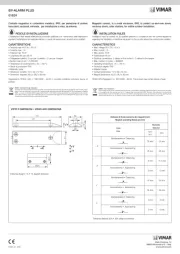
7 Juli 2025
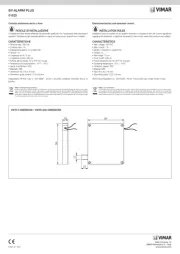
7 Juli 2025

2 April 2025

2 April 2025

2 April 2025

2 April 2025

16 December 2024

16 December 2024

16 December 2024

16 December 2024
Larmsystem Manualer
- Eufy
- Greisinger
- Smartwares
- Yale
- Basetech
- Werma
- ESYLUX
- Clas Ohlson
- Vivanco
- Imou
- DESQ
- Protector
- Redmond
- Cordes
- Dometic
Nyaste Larmsystem Manualer

9 Oktober 2025
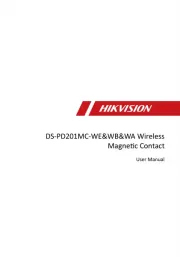
7 Oktober 2025
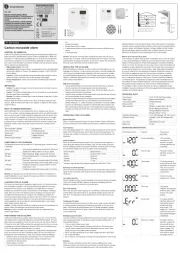
20 September 2025
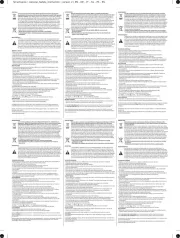
19 September 2025

19 September 2025
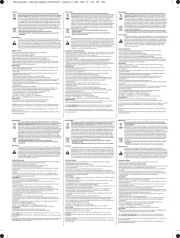
19 September 2025
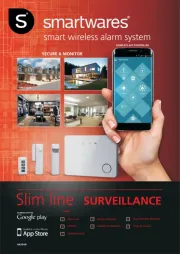
19 September 2025
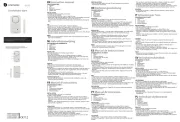
19 September 2025
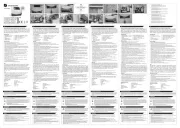
19 September 2025
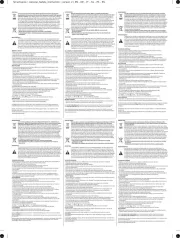
19 September 2025